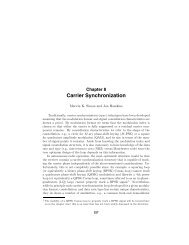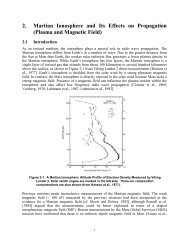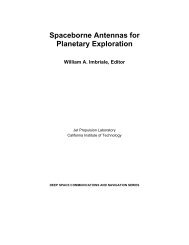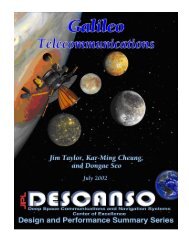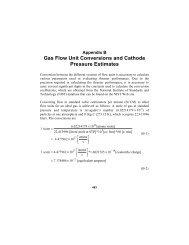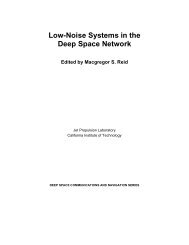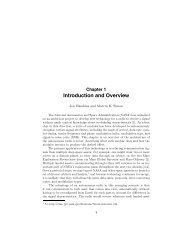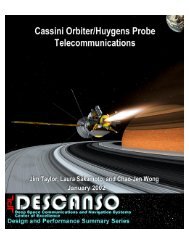Propagation Effects Handbook for Satellite Systems - DESCANSO ...
Propagation Effects Handbook for Satellite Systems - DESCANSO ...
Propagation Effects Handbook for Satellite Systems - DESCANSO ...
Create successful ePaper yourself
Turn your PDF publications into a flip-book with our unique Google optimized e-Paper software.
6.3 PREDICTION OF CUMULATIVE STATISTICS FOR RAIN ATTENUATION<br />
6.3.1 General Approaches<br />
6.3.1.1 Introduction to Cumulative Statistics. Cumulative<br />
statistics give an estimate of the total timel over a long period~<br />
that rain attenuation or rate can be expected to exceed a given<br />
amount. They are normally presented with parameter values (rain<br />
rate or attenuation) along the abscissa and the total percentage of<br />
time that the parameter value was exceeded (the “exceedance time”)<br />
along the ordinate. The ordinate normally has a logarithmic scale<br />
to most clearly show the exceedance times <strong>for</strong> large values of the<br />
parameter, which are often most important. ~ Usually, the percentage<br />
exceedance time is interpreted as a probability and the statistical<br />
exceedance curve is taken to be a cumulative probability<br />
distribution function. Because of the general periodicity of<br />
meteorological phenomena, cumulative statistics covering several<br />
full years, or like periods of several successive years, are the<br />
most directly useful. (A technique exists, however, <strong>for</strong> extending<br />
statistics to apply to periods greater than those actually covered.<br />
This is described in Section 6.3.4.) Statistics covering single<br />
years or periods would be expected to exhibit large fluctuations<br />
from year to year, because of the great variability of the weather.<br />
In most geographic regions, data covering ten years or more is<br />
usually required to develop stable and reliable statistics.<br />
Cumulative rain rate or attenuation exceedance statistics alone<br />
give no in<strong>for</strong>mation about the frequency and duration of the periods<br />
of exceedance. Rather, only the total time is given. The nature of<br />
rain attenuation, however, is such that the exceedance periods are<br />
usually on the order of minutes in length. Different phenomena<br />
besides rain give rise to attenuation variations occurring on a time<br />
scale of seconds. These amplitude scintillations~ as they are<br />
called~ are not considered in this section? but are discussed in<br />
Section 6.5.<br />
6-19





